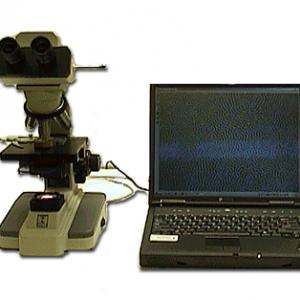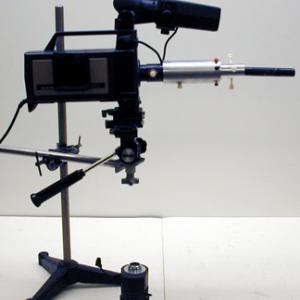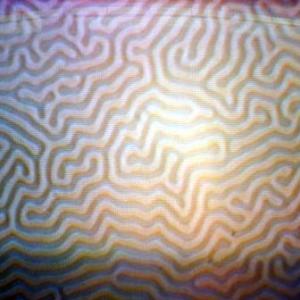College of Liberal Arts & Sciences
5G20.21 - Magnetic Domain Apparatus
Hook the video microscope to the lap top and screw the 20X lens into the microscope. With the microscope software actual measurements of the magnetic domains may be done.
Place the magnetic domain apparatus on the digital microscope and select the 20X lens on the microscope. Connect it to the lap top so that capturing and projecting can be done using the Motic software. To give magnetic fields that can be regulated, connect the 0-20 V power supply to the electromagnetic coil in the magnetic domain apparatus.
Screw off the lens of the camera that you are going to use. Screw in the mounting apparatus containing the magnetic domain apparatus. The magnetic domain crystal is made up of Bismuth, Thulium, Gallium, and Iron Oxide and is approximately 1 mm square. The apparatus is stored so that it should be within visible focus when attached. Adjust to a finer degree of focus as needed. The Mag-Lite is particularly useful here as it is a variable focus light source. This allows for a diffuse uniform light over the entire field of view that can be adjusted to bright point source if desired. The batteries in the light will last for approximately 1 to 1 1/2 hours. When using the Mag-Lite you also do not have to worry about heat damage to the magnetic domain crystal. The pattern that is seen may be changed by bringing a magnet near the unit. Note that one pole of the magnet will produce light lines on a dark background, and the other pole of the magnet will produce dark lines on a light background. There is also a electromagnetic coil mounted in the magnetic domain unit so that more exact measurements may be done using a power supply and several meters for measurements.
- Jeffrey J. Braun, "Tel-Atomic Magnetic Bubble Apparatus - An Evaluation", TPT, Vol. 20, # 5, May 1982, p. 330 - 332.
- Andrew H. Bobeck and H. E. D. Scovil, "Magnetic Bubbles", Scientific American, Vol. 224, # 6, June 1971, p. 78.
- Yaakov Kraftmakher, "5.5 Ferromagnetism", Experiments and Demonstrations in Physics, ISBN 981-256-602-3, p. 317.
- Richard E. Berg, "DEMO HINTS: Magnetic Domains on TV", PIRA Newsletter, Vol. 3, # 9, January 29, 1989, p. 3.
Disclaimer: These demonstrations are provided only for illustrative use by persons affiliated with The University of Iowa and only under the direction of a trained instructor or physicist. The University of Iowa is not responsible for demonstrations performed by those using their own equipment or who choose to use this reference material for their own purpose. The demonstrations included here are within the public domain and can be found in materials contained in libraries, bookstores, and through electronic sources. Performing all or any portion of any of these demonstrations, with or without revisions not depicted here entails inherent risks. These risks include, without limitation, bodily injury (and possibly death), including risks to health that may be temporary or permanent and that may exacerbate a pre-existing medical condition; and property loss or damage. Anyone performing any part of these demonstrations, even with revisions, knowingly and voluntarily assumes all risks associated with them.



